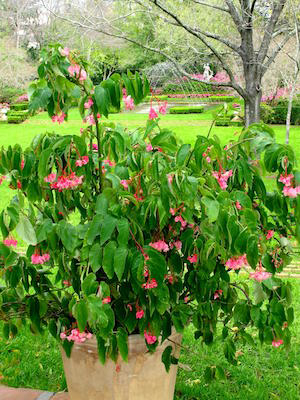
Many species of Begonia make striking container plants.
May 23, 2023 - The genus Begonia includes 2,000 species from tropical and subtropical Africa, Asia, Central and South America, along with thousands of hybrids created by enthusiasts around the world. Begonia leaves can resemble ivies, ferns, aralias, grasses, and peperomias. They can be flat, pebbled, shiny, hairy, fuzzy, or spiraled, and almost any color or combination of colors.
Flowers come in all colors but blue. They can grow as tiny single blossoms directly from a stem or as foot-wide clusters of hundreds of tiny flowers. Some tuberous hybrids have giant double blossoms ten inches or more in diameter. Begonias needing high humidity are grown in greenhouses or terrariums, while other types of begonias can be grown outdoors as bedding or container plants.
In some areas of North America and Europe, begonias are large landscape plants giving years of beauty and enjoyment. Here, most begonias are grown as annual bedding plants in shady landscapes but many of the more unusual species and cultivars are typically grown as pot plants.
The potting mix for begonias should be slightly acidic containing loose, well-draining ingredients such as perlite, vermiculite, sphagnum peat moss, and/or leaf mold (oak leaf, if available). Good commercial mixes work well.
The soil should become neither excessively dry nor allowed to stay sopping wet. A well-drained mix helps achieve optimum conditions. Plants should be watered thoroughly when the top of the mix becomes dry to the touch.
Begonias have shallow root systems. Except for tall-growing cane and shrub types, they prefer shallow pots. Repot only to the next larger pot as begonias do not like over-potting. Use either clay or plastic pots as cultural conditions require.
Begonias are classified as shade plants, but too little light will result in weak, spindly growth. Most varieties do well with direct morning sun or dappled sunlight all day long. Light that grows healthy African violets is good for growing healthy begonias. The common bedding semperflorens types, however, can also be grown in direct, daylong sun in most climates, especially if planted before summer.
If you’d like to learn more about begonias, the American Begonia Society along with the Southwest Regional Association of the society will be hosting their Annual Convention in Tyler May 24-27.
Begonias visit the Rose City is the theme of their convention. A number of members have already visited Tyler which included presentations to the Smith County Master Gardener Association and the Gertrude Windsor Garden Club.
Two events that are highlights of their begonia conventions are the plant sale and the begonia plant show. If you are looking for that unique begonia that you saw online, this may be the place to find it. The plant show will let you see a wide array of award-winning begonias. Both the sale and the show will be open to the public at the Holiday Inn Conference Center (5701 South Broadway) in Tyler. Hours for the show and sale are Friday, May 26th from 9 am to 5 pm and Saturday, May 27th from 9 am to 4 pm.
For more details, contact members Joyce Block (817933-2187) or Taddie Hamilton (817-602-4573). More information about begonias and the society can be found on their website (begonias.org).
Greg Grant is the Smith County horticulturist for the Texas A&M AgriLife Extension Service. He is the author of Texas Fruit and Vegetable Gardening, Heirloom Gardening in the South, and The Rose Rustlers. You can read his “Greg’s Ramblings” blog at arborgate.com and read his “In Greg’s Garden” in each issue of Texas Gardener magazine (texasgardener.com). More science-based lawn and gardening information from the Texas A&M AgriLife Extension Service can be found at aggieturf.tamu.edu and aggie-horticulture.tamu.edu.








